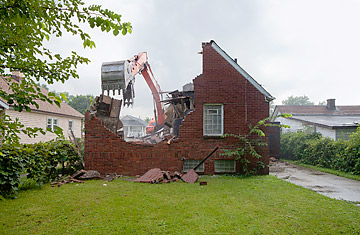
A home being destroyed in the Lee-Miles area of Cleveland
(3 of 5)
It's a figure worth remembering because, as much firepower as we think we've thrown at housing, we haven't done nearly that much, even though housing prices have dropped further this time than when FDR was President. Two and a half years on from the crisis, just 760,000 Americans, or 1.5% of the country's 51 million mortgage holders, have received modifications through Barack Obama's signature program, the Home Affordable Modification Program — and nearly half of them have defaulted anyway. After a total of $18 billion in government spending on housing bailouts since 2008, the President declared in early July that the efforts had largely failed: "We're going back to the drawing board."
Indeed. In Washington, policymakers have been heard to fantasize about bulldozing 3 million homes nationwide in order to turn the economy around. That won't happen — at least not yet. But this fall, the Administration is planning to introduce new housing measures as part of a desperate push to speed recovery ahead of the 2012 elections. A debate is under way inside the White House over just how far to go. Economists briefing the Administration are pushing radical housing ideas, and history has already taught us that that may be what's required to turn around the U.S.'s $18 trillion housing market. Below are four of the most-talked-about proposals and how they'd work.
1 LIFT THE DEBT BURDEN
Early in Obama's term, Yale's Geanakoplos tried to persuade top White House advisers to launch an updated version of FDR's massive mortgage-release plan by writing down mortgage principal nationwide. The Administration feared it would hurt the banks, which would have been forced to write down the value of the loans on their books. Three years and, by Geanakoplos' count, 2.5 million evictions later, the argument is increasingly irrelevant. The banks have had to write down the loans anyway, and economists are calling for more bailouts. Now the Administration and the banks say they fear moral hazard — the idea that a bailout for people who haven't been making their mortgage payments would encourage those who are making them to become delinquent too.
There are ways around that problem. The easiest fix is to refinance home mortgages at today's historically low interest rates. But a combination of bad credit, underwater loans and banks' reflexive fear of postcollapse lending means that refinancing is much tougher than it used to be. That, says R. Glenn Hubbard, who was George W. Bush's top economic adviser from 2001 to '03, presents a huge opportunity. Now the dean of Columbia Business School, Hubbard is proposing with colleagues Christopher Mayer and Alan Boyce a national refinancing of mortgage debt for the estimated 37 million federally guaranteed loans Americans have with government mortgage issuers like Fannie Mae and Freddie Mac. The issuers would send borrowers an application to refinance at current low mortgage rates; the borrowers would have to be current or become so for at least three months; no down payment would be required; and the government would guarantee the new loans just as it chose in 2008 to guarantee the existing ones, meaning taxpayers would not be taking on any new risk.
A national refinancing effort could slow the number of foreclosures by making mortgage payments more manageable for borrowers who can stay in their homes if they get a few thousand dollars a year in interest savings. It might also stimulate consumer spending — Hubbard estimates $50 billion to $70 billion worth — as homeowners wouldn't feel quite so pinched. "A national refinancing would be like a large, permanent tax cut which would have a very big effect on the economy," says Hubbard, who has briefed the Obama Administration since he introduced the idea.
